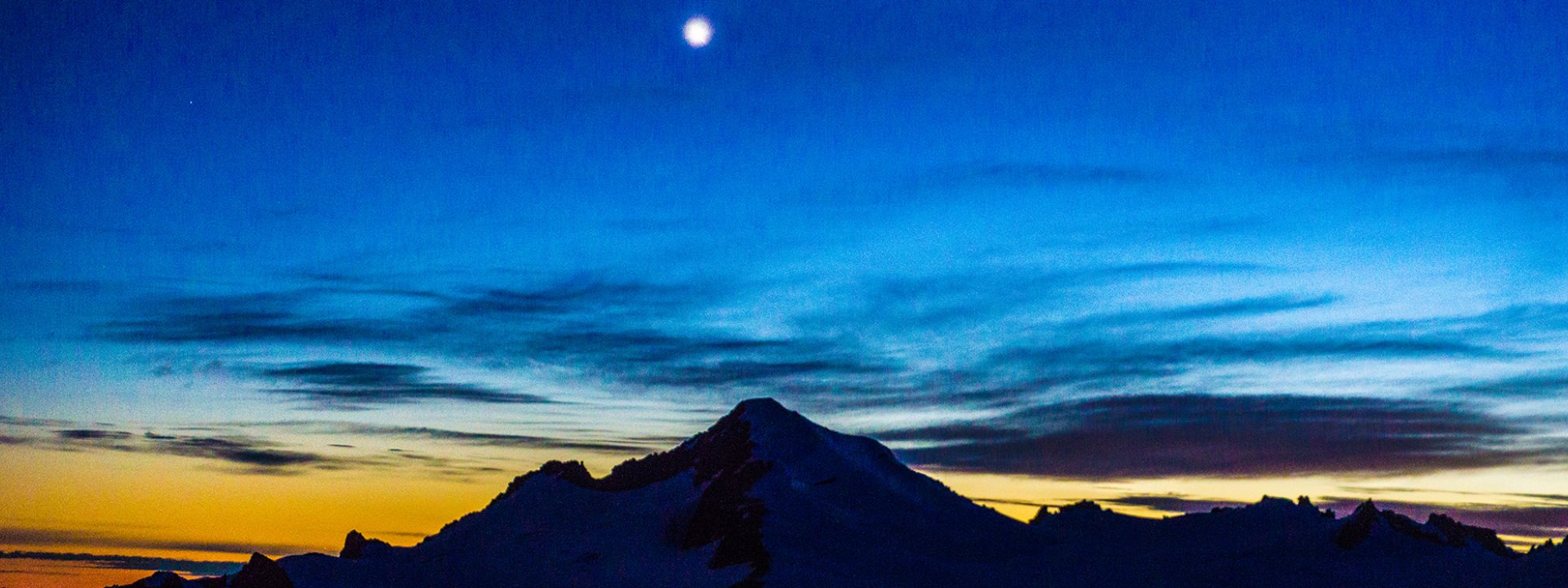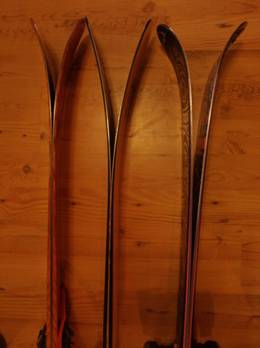How to Choose a Backcountry Ski
Choosing the perfect backcountry ski is a daunting task these days. Ski design has gone through a dramatic evolution over the past five years. You could argue that this dramatic evolution has been going on for the last twenty years, but the most recent developments in this evolution have had a major influence on how well skis perform in the backcountry.
So what are these improvements and how do we decide what’s important and what’s just ski industry marketing hype? The most important aspects to focus on when looking at a backcountry ski are:
- Rocker
- Width
- Shape
- Weight
Rocker – If it doesn’t have it, don’t buy it!
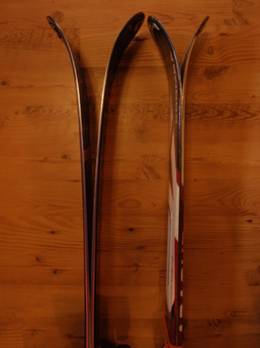
Tip Rocker
Rocker, reverse-camber, early-rise, splay, whatever you want to call it, it’s more than just marketing hype. This is a game changer when it comes to ski performance in the backcountry.
So what is it? A ski with rocker is bent toward the topsheet, or has what you would call reverse camber (picture the legs of a rocking chair). This can be in both the tip and the tail, just the tip or throughout the entire ski. In the picture (to the right) you can see the comparison between a ski with significant rocker (2010 K2 Obsethed on the left) to a ski with zero rocker (2007 K2 Coomba on the right). This change in camber allows the ski to float effortlessly in powder and helps ease turn initiation.The other major benefit of rocker is that it allows the skier to stay centered on the ski. Before tip rocker and wide skis, you often had to ski with your weight on your heels, or in the back seat, in order to avoid going over the handle bars when skiing deep or variable backcountry snow. This not only burned your quads but also made it difficult to finish the turn because all of the weight was on the tail of the ski. This would prevent the skier from being able to feather the turn and change the turn shape. Now, with a rockered ski, you can stay more centered and ski deep and variable snow with confidence and ease.
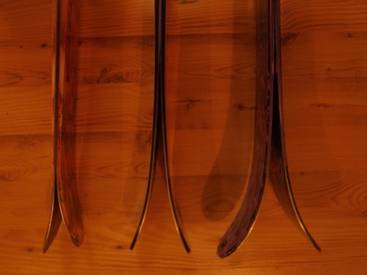
Tail Rocker
Many skis these days offer rocker in both the tip and the tail. While true twin tipped skis (like the skis on the right in the picture to the right) are meant for skiing backwards, rocker in the tail serves a different purpose. Its main purpose is to help ease the finish of the turn. More tail rocker means a “looser tail”, providing a more “surfy” feel to the ski.
Many backcountry skiers prefer to have a flat tail with no rocker. A ski with a flat tail makes certain types of kick turns easier and makes the ski more useful for snow anchors both for rope work and for quick security on steep slopes.
Varying amounts of Tip Rocker
The amount of rocker will vary from ski to ski. The picture on the right shows three different skis with three different amounts of rocker. How much is enough? That’s a tough question to answer. It all depends on skier preferences, flex patterns, tip shape, etc… etc… It’s a question that most ski manufactures are trying to answer themselves. Just make sure your next backcountry ski has some rocker.
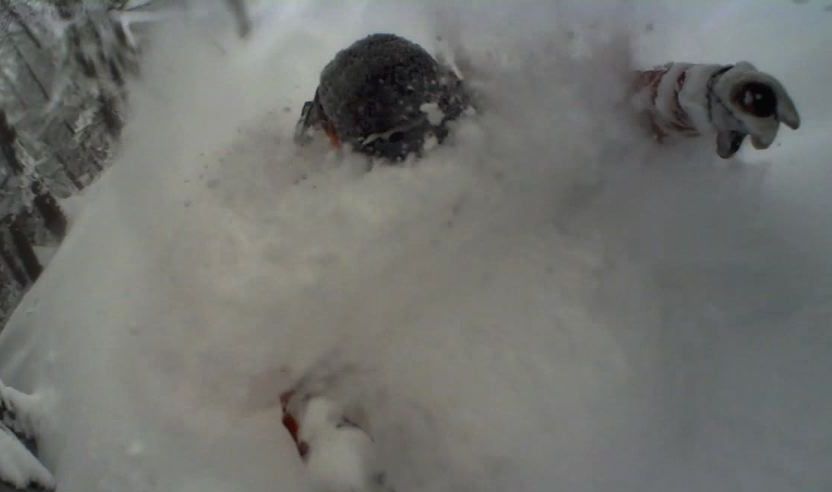
Another DEEP day!
Bigger is better …..
…..when it comes to ski performance in soft and variable snow. A wide ski allows the ski to plane to the surface faster and easier. This helps provide a more forgiving platform and allows easier turn initiation and finish. It also allows the backcountry skier the option of skiing low angle terrain when the avalanche danger is high because the increased floatation equates to increased speed (when desired).
Increased width does come at a price. More width means more weight and more skin drag on the uptrack. Finding a balance between wide enough but not overkill will come down to personal preference. For example, Jeff’s preferred mid-winter touring skis are in the 110 to 120 mm range underfoot, while Larry’s preferred skis are in the 95 to 110 range.
Lotus 138
Shape – It’s not all about side cut these days.
Back in the mid-90’s “shaped” skis revolutionized the ski industry. Increase side cut (picture a ski shaped like an hourglass) made carving on firm snow much, much easier. While this is an advantage on firm or groomed snow, increased side cut does have some disadvantages in the backcountry. A ski with dramatic side cut tends to be a little more “hooky” and unpredictable in soft or variable snow.
To address this issue some companies have gone as far as offering reverse side cut in their powder skis, where the waist is actually wider than the tip and tail. Other companies offer skis that have “pin tails” where the ski is shaped more like a tear drop. The popular K2 Pontoon and DPS Lotus 138 (shown above) are good examples of this design. This creates a ski with an amazing amount of float and makes it nearly impossible to sink the tip.
Wailer 112
The most popular shapes these days have been the shapes that mimic a ski with reverse side cut but have a small amount of traditional side cut underfoot to increase firm snow performance. The DPS Wailer 112 (shown above) and Armada JJ are good examples of this design.
Weight– It’s all about the down but you have to get up the thing first. 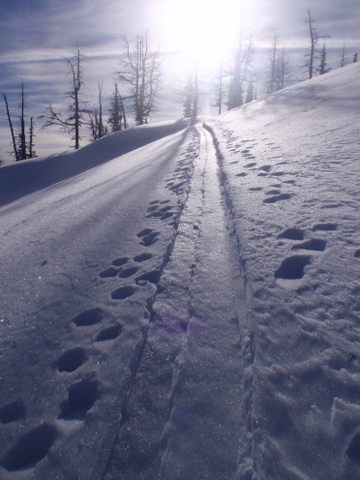
Well, here comes some of the bad news. While wider may be better, wider usually means heavier. Luckily advances in ski construction technology have helped. With a sizable increase in the backcountry skiing population over the past ten years, the ski industry has more motivation to decrease the weight of their skis. Many companies are starting to incorporate carbon fiber and lighter weight wood cores in an effort to decrease weight. At times this can produce a ski with decreased performance but many companies have found a good balance between weight and performance.
Here are a few tips that might help you decrease the weight/increase efficiency while still enjoying the benefits of a fat ski:
- Pay attention to ski weights. Skis with the exact same dimensions can have dramatically different weights.
- If this is going to be a dedicated touring set up go with a Dynafit-style binding. You can save anywhere from a pound to over 3 pounds a pair when compared to beefier binding like the Marker Duke.
- If your skis are wider than 115 mm underfoot consider using a “split skin” such as the Black Diamond Split STS Skins. These skins have a smooth nylon center strip that decreases weight and increases glide.
- For skis that are too narrow for the split skin, make sure you go with a skin with good glide. Skin glide has a huge impact on uphill efficiency. You already have enough grip due to the amount of plush on a fat ski’s skin. Glide is what you need.
- Consider going with a lighter touring boot. Boots like the Dynafit TLT 6 Performance weigh in at half the weight of a beefier boot, have an excellent tour mode, and perform well on the down. As these skis get easier and easier to ski a beefier boot becomes less of a requirement.
Conclusion
While all of these technological advances are making it more confusing to pick out the perfect backcountry ski, these advances are increasing the enjoyment in an activity that was pretty enjoyable to begin with – backcountry skiing. If you take these four factors into account when shopping for you next pair of skis – rocker, width, shape and weight, you will likely end up with a great pair of backcountry fun sticks.
What the guides are skiing on this year
To help you get an idea of the type of skis we are talking about, here is what the guides are skiing on these days:
~Larry: 5’6″, 140 lbs, 43 years old, a strong and aggressive skier. Can ski on telemark, randonnee, and in any conditions. For years Larry has loved his 178 Dynafit Manaslu calling it one of the most versatile skis he has ever been on. The rockered tip does an amazing job at keeping the skis on the surface in any snow conditions. He uses Dynafit Vertical bindings and cant imagine touring on anything else. Larry added a fat touring ski to his touring quiver last year, the Dynafit Huascaran and is now torn between two favorites. The majority of Larry’s telemarking these days is done in the lowlands of the Methow Valley on the Karhu Guide with 3 Pin bindings and Garmont Excursions. For Boots larry uses the Garmont Radium for touring and the Garmont Delerium for Heli guiding.
~Jeff: 5’9″, 150 lbs, 44 years old. Ex- ski instructor and ski racer. Prefers a surfy, playful ski as opposed to a beefy plank. Like many of the guides Jeff has a large selection of skis for a variety of conditions, with rocker being a common theme throughout the quiver. Once again this year Jeff will be touring on the DPS Wailer 112 (tip and tail rocker). Jeff can’t stop raving about this versatile ski. When using the lifts or the helicopter Jeff will be choosing between a pair of K2 Pontoons (reverse camber) and K2 Shreditor 112 (twin tipped with tip and tail rocker). For boots Jeff tours with the Dynafit TLT 6 Performance.
~Paul: 6’0″,170 lbs, 47 years old; a strong and graceful skier; spends most of his time alpine touring on a pair of Dynafit Manaslu’s with Dynafit TLT bindings but you can sometimes find him breaking out an old pair of telemark skis to relive his past. Likes to ski fast and go big. For boots Paul uses the Dynafit ZZero.
~Josh: 5’8″, 155lbs, aggressive skier that likes speed and longer radius turns. Josh skis tele on Voile Chargers (181cm) and black diamond O1 bindings (free pivot touring mode is absolutely critical in the modern tele setup) with Black Diamond Push boots (He really likes the new BD liners with the cable lacing system as it allows for a snug liner and a loose shell, which is ideal for touring with full ankle motion but no blister-causing sliding of the heel). For AT, Josh again skis the Voile Charger with Dynafit TLT bindings and Dynafit ZZero 4 C-TF boots. He has grown to truly love the Voile Charger in soft and variable snow.


